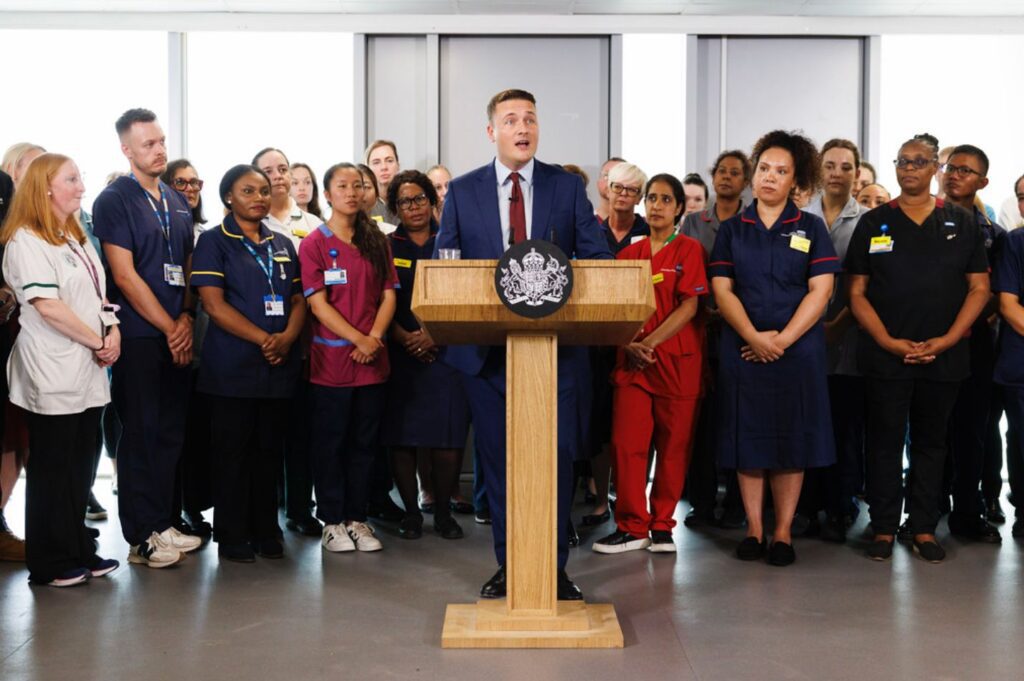When my NHS doctor broke the news I had cancer, no matter how gently they delivered that diagnosis, the revelation still hit me hard. But what happened next was amazing.
The NHS wove its web of care around me. From the get-go, I was supported with compassion, empathy, and world-class treatment by an incredibly dedicated team of doctors, nurses and surgeons tasked with helping me beat the disease. The NHS saved me. They saved me. My gratitude and respect for what they did is limitless.
For more than 76 years, our national health service has been saving and supporting all of us – our friends, families and loved ones – through every life stage. Truly, this organisation is woven into all our lives and my connection to it feels more personal than ever.
The NHS under threat
Healthcare, free at the point of use for all, is one of Britain’s noblest principles, admired around the world. It is an enduring principle that drives me every day. Yet now, the very idea of the NHS remaining free at the point of use is under threat.
Lord Darzi’s 2024 review of the NHS, commissioned by this government, highlighted some shockingly critical problems. Patient access had deteriorated: waiting lists for hospital, GP, and mental health services had ballooned. Meanwhile, A&E delays were posing genuine risks to patient safety. Resources were poorly allocated: too much being spent on hospitals, while community care and capital investment had been woefully neglected, leaving buildings crumbling and technology languishing in the last century. Productivity was low despite increasing staff levels, with poor patient flow and inefficient processes holding back output. Together, these challenges had left the NHS overstretched, inefficient, and struggling to meet rising demand.
“Of course we already knew, before entering government, that business as usual was not an option” ~ Secretary of State for Health and Social Care Wes Streeting MP.
Lord Darzi’s report simply confirmed the scale and urgency of the task: the “money in, poorer services out” cycle has to end.
10-Year Health Plan
That is why, earlier this year, we launched the most extensive public engagement on the NHS in a generation, Change NHS, culminating in the publication of the 10-Year Health Plan (10YHP).
This is not a short-term sticking plaster, but a long-term strategy to re-energise the health service. What differentiates it from past efforts is delivery: the plan is already being implemented, backed by real funding and structural reform.
At its core are three “big shifts”:
• from hospital to community,
• from analogue to digital,
• from sickness to prevention.
These ambitions are not new, but this time they are matched with the resources, workforce, and accountability needed to make them real. The first months of implementation have shown what delivery looks like in practice:
Funding: an additional £29 billion has been committed in real terms over the next three years, not just to patch holes, but to invest in long-term productivity and reform.
Workforce: over 2,000 extra doctors are already in post, with further expansion underway.
Thousands of new appointments have been released through recruitment and smarter scheduling, giving patients faster access. And now, instead of sending every patient straight into a hospital queue, more GPs are getting rapid expert advice from specialists on when referrals are needed. Hundreds of thousands of people are now avoiding unnecessary delays and receiving faster treatment closer to home. The 8am scramble to book GP appointments is over for many as practices keep online booking systems open outside core surgery hours.
Cancer and diagnostics: advances in screening and detection technology are being rolled out nationally, enabling earlier diagnosis, intervention and better survival rates.
Med-tech innovation, from AI-assisted imaging to faster blood tests, is moving from pilot to practice.
Reducing waiting lists: the backlog is turning a corner. By expanding capacity, streamlining pathways, and tackling inefficiencies, we are shortening waits that frustrate patients and demoralise staff.
Productivity and efficiency: a determined drive to reduce agency spend is paying off, with more shifts covered by permanent staff, stabilising teams and saving money that can be reinvested in frontline care.
Indeed, acute trust productivity rose by 2.7 per cent over the past year, higher than our two per cent target.

“Early wins” driving the 10 year plan
Leadership and accountability: for the first time, underperforming trusts are being named in league tables. This transparency is driving a culture shift: strong leadership will be celebrated, while failing institutions are expected to improve rapidly under clear mandates.
These early wins demonstrate the plan is not just about aspiration, it’s about delivery, and it is already changing the patient experience.
One of the most significant reforms underway is the creation of Neighbourhood Health Centres, integrating GPs, community nurses, mental health professionals, and diagnostic services under one roof. By offering credible local alternatives, these centres will, over time, reduce hospital admissions and ease pressure on acute wards. Crucially, Integrated Care Systems (ICSs) are being empowered to adapt these models to local needs, while being held accountable for results. This blend of local flexibility and national rigour is the bedrock of sustainable reform.
NHS app – a “digital front door”
The NHS App is also evolving into the true “digital front door” of the service. By 2027, the NHS will have effectively set up an ‘online hospital’ – NHS Online. This digital innovation will connect patients to expert clinicians anywhere in England. Already, thousands of extra appointments have been booked digitally, saving patients time and reducing administrative burdens for staff.
“Perhaps the most profound shift is a renewed focus on prevention” ~ Secretary of State for Health and Social Care Wes Streeting MP.
From reactive to proactive care
For too long, the NHS has been forced into reactive care, treating illness once it has taken hold. That is changing. Expanded screening, vaccination campaigns, and proactive management of chronic conditions are now central to delivery. These measures are not only cost-effective but also vital to addressing health inequalities, not least in the younger generation. That’s why we’ve moved to ban sales of energy drinks to under 16s, announced restrictions on junk food TV advertising before the 9pm watershed, and tasked supermarkets to tackle obesity by setting new standards to make the average weekly shop healthier.
Life expectancy still varies dramatically across England. By embedding prevention into local services, we are beginning to close the persistent gap in outcomes between wealthy areas and deprived coastal or rural communities.
The NHS is being given the clarity it has long lacked. The new mandate sets sharper performance requirements on waiting times, GP access, urgent and emergency care, and cancer diagnosis, with progress published openly.
Improvement plans are no longer optional. Autonomy is being earned by results, while decisive interventions are made where standards are not met. This is how we will make sure ambition is translated into outcomes for patients.
Final thought
The 10-Year Health Plan is ambitious, but it is also practical, realistic, and frontloaded to deliver
Patients are beginning to see shorter waits and better access. Staff are benefiting from clearer priorities, stronger support, and a renewed sense of purpose. This is the NHS we all want. A modernised national health service, one that is stronger, fairer, and reflective of our increasingly diverse and complex society.
By embracing innovation, investing in people, technology, and prevention, we’re building an NHS fit for the future: resilient, responsive, and ready to serve the health needs of this country for generations to come.





